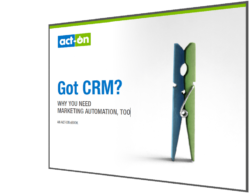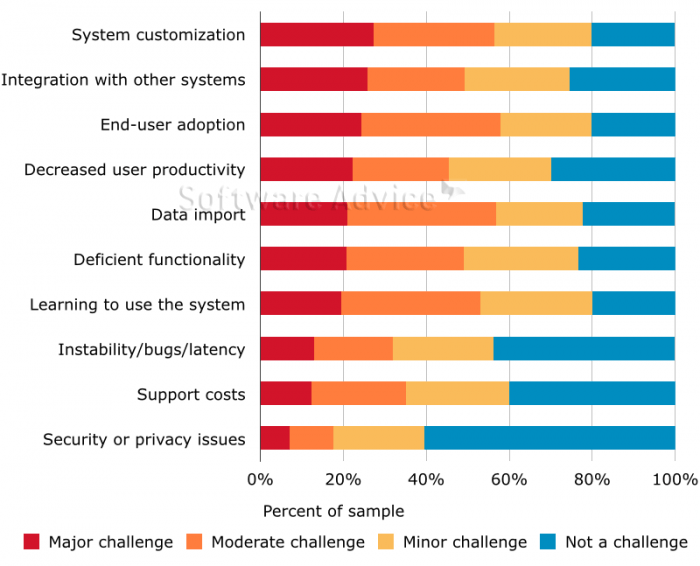Customer relationship management (CRM) systems are vital to businesses both large and small across multiple industries. A well-chosen and ably used CRM solution can save time, reduce costs and help your sales and customer service teams become more productive – and more effective. But how do CRM users feel about the solutions they’re using currently? Do they find them lacking in critical ways? And what are some of the challenges ahead? Let’s take a look at the results of a recent survey from software evaluation company Software Advice, in the report, “Customer Relationship Management Software UserView 2014” to find out.
It seems like ever since CRM was introduced to the market in the 1990s, it’s been continually changing the game, making it possible for businesses to drive engagement, increase revenue, and deliver superior service. Indeed, according to the Software Advice survey, CRM users are generally satisfied with the solution they’re using. Most users (74%) said their CRM system offered improved access to customer data, and 64% said that it delivered improved relationship management.
So far, so good. But what does the future hold for CRM users?
A key finding from this report indicates an interesting trend for CRM implementations: The two most commonly cited areas for increased CRM technology investment are customer service, at 47%, and marketing automation, with 42% indicating they plan to increase spending on these solutions.
Clearly, improving the help desk experience – and ensuring better customer service – is extremely important to developing strong customer relationships, and investing in technology solutions to improve these business areas can deliver a significant competitive advantage. But marketing automation is next on the list of importance for a good reason. For all CRM’s many strengths, no CRM system offers what today’s marketer needs in order to develop lasting customer loyalty and also support overall business goals. It’s no wonder CRM users plan to invest in marketing automation, especially when you consider the many benefits of the kind of synergy they can create.
Focus on Customers
Integrating CRM with the marketing automation makes it possible to develop new levels of engagement with customers and prospects throughout the entire marketing and sales journey. Using the two solutions together, marketers can create and produce more targeted email marketing, lead generation, and lead nurturing campaigns without the need for additional specialized resources.
The integration of marketing automation and CRM results in a whole that is mare than the sum of its parts. Businesses can build closer relationships with leads without risking exponential growth in time and money invested. Lead management programs can help make strategic use of assets, delivering them when – and where – customers expect to find them. Automated programs make it possible to replicate every successful campaign and run them at scale, giving reach over time and volume with less effort – and more precision.
Matt Heinz, President of Heinz Marketing, put it this way:
“In a nutshell, the only thing CRM systems do is organize your information. They don’t actually do anything. They keep track of your sales, but they don’t engage your prospects. That’s still up to you. They capture your sales process, but they don’t execute it. A good marketing automation system, on the other hand, proactively helps you. If set up and managed well, you can sit back and do nothing and the system will drop interested prospects in your lap … I don’t actually recommend someone choose one or the other. World-class sales and marketing organizations need both to succeed and scale.”
With the right combination of marketing automation and CRM, marketing teams can:
- Create, automate, and measure lead nurturing and marketing campaigns
- Track website visits and understand potential buyer interest
- Score leads based on specific activities, profiles and special events
- Automatically manage, recycle, and reassign sales leads based on specific behaviors
And sales teams can:
- Better define and manage lead qualification and lead hand-off timing
- See exactly why a lead has been qualified and assigned to them
- Fully understand, prioritize, and interact with only the hot prospects.
- Gain intelligence about a prospect’s interests and activities
- Be prepared for a call with a talk track drawn from the lead’s demonstrated interests
- Collaborate on the amount, type and timing of content to prospects
Nurturing leads often results in not only a higher percentage of closed leads, but also bigger deal sizes. The buyer is better-educated, and the relationships are stronger and more personal. In short, marketing automation, combined with CRM, provides a significant business advantage.
Ensuring Integration
Another interesting finding from the Software Advice report is an overview of the challenges organizations say they have with their current CRM system. System customization was the biggest pain point, with 56% saying it is a major or moderate challenge; 49% of respondents citing integration as a more than minor challenge.
Customization’s lead in this category is unsurprising. Every customization is by definition a one-off, providing the opportunity for problems no one has ever seen before. Often a third party is in the mix to plan or execute the implementation. If communications aren’t thorough and precise, it’s easy for misunderstandings and mistakes to slow progress. The most common surprise is the unforeseen escalation of budget, or the schedule that’s been overshot. Or (usually) both.
Integration is also an issue since, as we saw previously, many organizations are looking to extend the functionality of their CRM with customer service options, marketing automation technologies, social media tools, and many other features necessary in today’s business environment.
But the more disparate systems you bolt to a platform, the more unwieldy the platform can become. Data starts existing in silos. Marketers can become spreadsheet jockeys, downloading data here, changing the fields, uploading data there, changing fields again. It takes longer to get the insights you need to take action – which was the whole point of adding on solutions in the first place. It’s no wonder that for marketers and sales teams, the need for seamless integration of CRM with a variety of other systems is critical, provided that the data can flow together so it can be analyzed and used as one body of knowledge.
What other challenges and opportunities are CRM users experiencing? Read the Software Advice UserView: CRM Software Report to find out.
And be sure to read Act-On’s new eBook, Got CRM? Why You Need Marketing Automation, Too to learn more about the benefits of combining marketing automation and CRM.



